AFM Systems
AFM Accessories
Learning
Contact Us

The Asylum Research MFP-3D family of AFM's extend beyond basic topography measurements with a diverse set of available accessories designed to enhance the capabilities of the AFM. These include accessories for making nano-electric measurements, for example conductivity and piezoelectric response, measurements under magnetic fields, measuring nanomechanical properties, and controlling the temperature and humidity. The MFP-3D accessories make it one of the more versatile AFMs on the market suited for a wide range of applications and research.
This page describes further in detail some of the accessories available and highlights research performed with them.
Get information from an AFM expertConductive AFM is a powerful current sensing technique for electrical characterization of conductivity variations in resistive samples. It allows current measurements in the range of hundreds of femtoamps to ten microamps. Conductive AFM can simultaneously map the topography and current distribution of a sample. It is a measurement useful in a wide variety of material characterization applications including thin dielectric films, ferroelectric films, nanotubes, conductive polymers, and others.
The ORCA™ Conductive AFM probe holder provides conductive AFM imaging and I-V measurement capabilities for all MFP-3D AFMs. The standard module is capable of measuring currents from ~1 pA to 20 nA.
For measurements that need a larger range there is a Dual Gain ORCA holder version. The Dual Gain ORCA option uses two separate amplifiers for an even wider current range, from ~1 pA to 10 μA. Unlike logarithmic amplifiers of other AFMS the Dual Gain ORCA holder does not have limited measurement sensitivity and resolution at lower currents.
The ORCA probe holder fits just like the standard holder and is capable of all imaging modes that the standard probe holder can perform. The included ORCA Sample mount allows you to apply bias voltages to your sample.

ORCA Sample Mount (left) and Canitlever Holder (right)
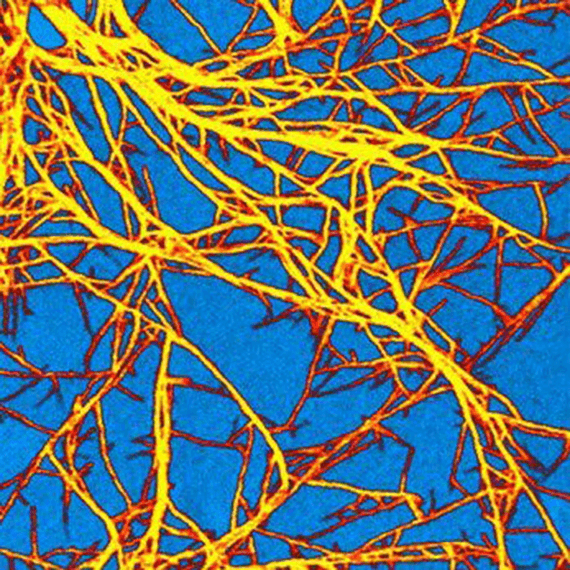
Photocurrent image of a fullerene capped conjugated polymer film. The polymer self-assembles into nanofibers. Photoconductive-AFM image collected at 0 V under white light illumination shows high photocurrent generation from the fibers. Imaged with the MFP-3D AFM. Image courtesy of D. Kamkar and T.-Q. Nguyen, UCSB.
Electromechanical coupling is one of the fundamental mechanisms underlying the functionality of many inorganic macro-molecular materials, including piezo- and ferroelectrics. PFM measures the mechanical response when an electrical voltage is applied to the sample surface with a conductive tip of an AFM. In response to the electrical stimulus, the sample then locally expands or contracts.
The Piezo Force Module enables operation at high tip biases up to ±220 V for very high sensitivity and crosstalk-free measurements on piezoelectrics, including ferroelectrics and multiferroics. High probing voltages can characterize even the weakest piezoelectric sample and allow measurements on a variety of materials and devices that previously could not be measured using PFM.
The Asylum PFM module supports the patented Dual AC Resonance tracking (DART) PFM mode. This mode offers increased stability and signal to noise. Also includes single frequency, lithography, and vector PFM modes.
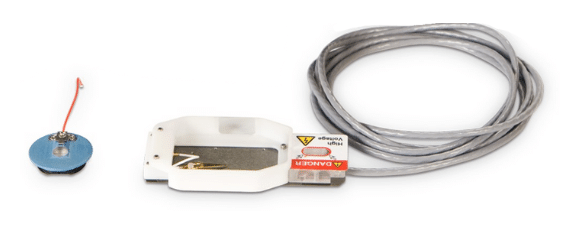
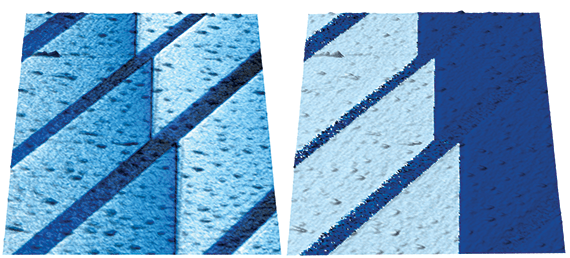
PFM amplitude overlaid on AFM topography (left) and PFM phase overlaid on topography (right) on (100) oriented BaTiO3 single crystal (from Castech Crystals). The amplitude and phase image show 90° and 180° domain walls in BaTiO3. 10 µm scan courtesy of V.R. Aravind, K. Seal, S. Kalinin, ORNL, and V. Gopalan, Pennsylvania State University
The Variable Field Module 4 (VFM4) is ideal for magnetic force microscopy and other applications where the sample has a dependence on the applied magnetic field. The VFM4 can apply adjustable in-plane magnetic fields up to 8000 G and out-of-plane magnetic fields up to 1200 G. Unlike competing designs, it uses permanent magnets to avoid heating and associated drift.
Though most often used in conjunction with magnetic force microscopy (MFM), the VFM4 is also used with techniques like conductive AFM (CAFM) and on diverse samples including piezoelectric and ferroelectric materials. No other commercial solution offers the same capabilities, versatility, and ease of use for magnetics research.
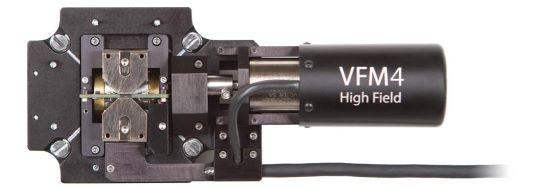
The VFM4 is a small stage that easily mounts to the MFP-3D scanner. This image shows it in its in-plane field configuration.
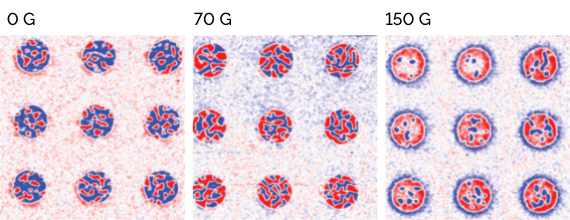
Magnetic skyrmions in Co-based thin film pads Imaged with MFM under out-of-plane magnetic fields. Each pad is ~900 nm in diameter. Images courtesy of K. Bouzehouane, Unité Mixte de Physique CNRS, Thales, Univ. Paris-Sud, Université Paris-Saclay, France.
Asylum’s exclusive AM-FM Viscoelastic Mapping combines the features and benefits of standard tapping mode with nanomechanical property mapping.
Standard tapping mode provides non-invasive, high-resolution topographical imaging, while the resonance of the second mode is analyzed to quantitatively estimate both the elastic and loss moduli of the material and the tip-sample dissipation.
With a range of applicability that spans a remarkable six orders of magnitude in storage modulus (from less than 1 MPa to hundreds of GPa), it is a general-purpose technique for anything from biomaterials and polymers to metals and ceramics.
AM-FM on the MPF-3D AFM requires the High Frequency Probe Holder accessory.
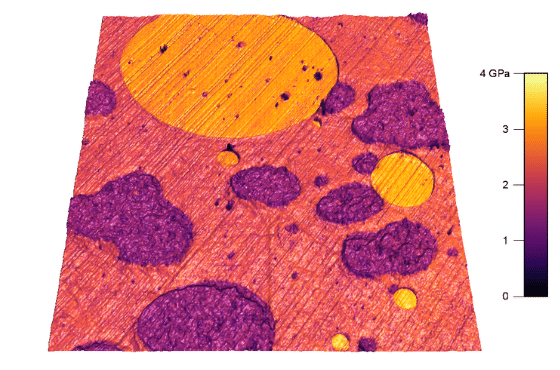
Polymer blend sample composed of polyethylene (darkest), polypropylene (matrix) and polystyrene (brightest). The 3D overlay of elastic modulus on topography. Image size: 25 um.
Control the temperature of your sample with either the PolyHeater or CoolerHeater accessory.
The PolyHeater consists of a metal heating stage embedded in ceramic and high-performance plastic. The heating stage can be used with a standard cantilever holder for heating up to 250°C. The sample stage accepts magnetic AFM mounting discs and has clips and threaded holes for other sample mounting methods.
The CoolerHeater accessory uses a Peltier element to heat and cool small samples within the range of -30°C to +120°C, ideal for a wide range of thermally-controlled experiments.

PolyHeater and CoolerHeater Sample Stages

Syndiotactic polypropylene melted to 160°C, then allowed to crystallize at 105°C. The initial image (top left) shows cooling after approximately five minutes. The remaining images show the crystallization process occurring after the amount of time shown, 80 µm scans.
The Humidity Sensing Cell is an accessory which independently measures humidity conditions with a sensor located within a sealed sample cell. This accessory also allows for simple humidity control. It is ideal for experiments where relative humidity plays an important role, such as crystal growth.
The Humidity Sensing Cell is a small sealed sample chamber with a dedicated side access port for the solid-state humidity sensor. The sample cell accepts samples of up to 30 mm in diameter. Samples are mounted on a glass disc which forms the bottom of the cell. Optical access is available from above and below the sample. A clamp and FKM (Viton® equivalent) membrane fit on top of the cell for an airtight seal.
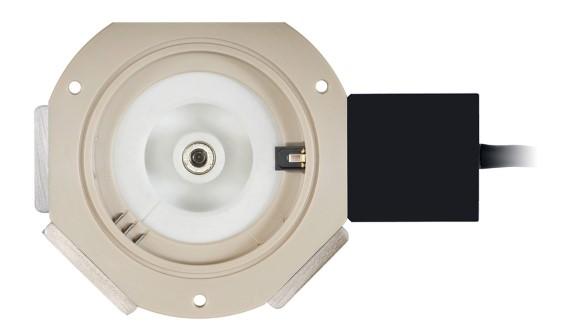
Humidity Sensing Cell
Enhance your AFM’s capabilities
Contact us to discuss how accessories can expand your MFP-3D AFM’s research capabilities, and to request pricing for new systems, upgrades, or individual accessories.
The accessories described above are available on the MFP-3D Origin+, MFP-3D Infinity and MFP-3D Bio. Some accessories described are not available on the MFP-3D Origin. See the MFP-3D Origin page for more details.
Browse our full list of MFP-3D AFM accessories.